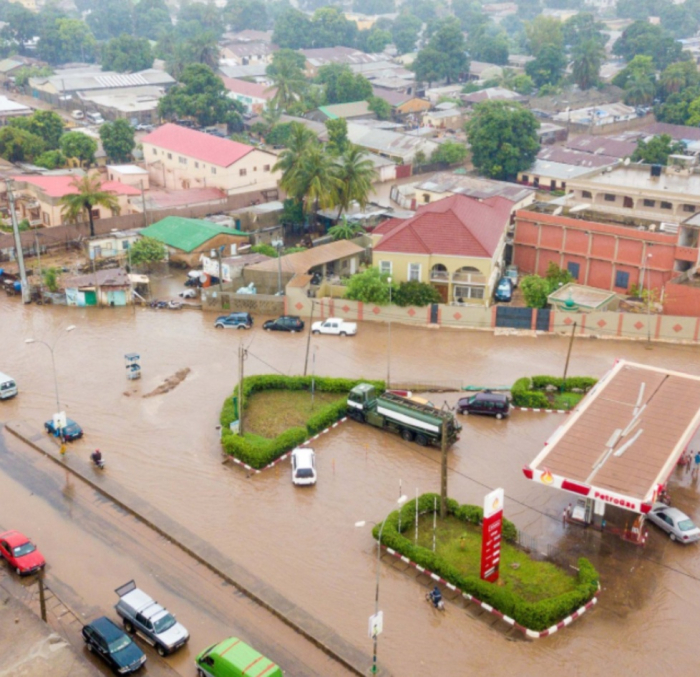
From Brikama to Churchill’s Town, and Latrikunda to Banjul, residents endure flooded homes, stalled vehicles, rotting goods and a growing fear for their health and safety.
While the rains are seasonal, the suffering has become a yearly reality that Gambians say requires urgent solutions.
At the heart of the problem are The Gambia’s markets where traders and customers wrestle with dirty floodwaters and blocked drains.
Fatou Colley, a vendor at Brikama Market said every downpour brings losses. She explained how the market is covered in stagnant water when it rains, causing loss both in produce and customers. This is their only source of income but the conditions are unbearable and despite repeated pleas for drainage and better waste management no lasting solution has come.
Binta Njie, a frequent market customer shared the same frustration as she often avoids the market during heavy rains because of the stench and risk of contamination. She explained that it is difficult to buy food in a place where dirty water mixes with waste as many people look for drier and cleaner places to shop.
The suffering extends to drivers and pedestrians as Buba Darboe a commercial driver, said flooding creates long traffic jams and sometimes makes roads impassable. He lamented how vehicles get damaged, causing costly repairs. Pedestrians complain of open gutters, blocked sidewalks and dangerous hidden holes making walking risky especially for schoolchildren and the elderly.
At Churchill’s Town, resident Isatou Camara described the area as a no-go zone during heavy rains with traffic often trapped for hours and some roads completely underwater. She stressed that expanding drainage is not optional but a necessity to ease transportation and improve daily life.
At Latrikunda Sabiji, taxi driver Harona Sey blamed poor urban planning as feeder roads and water canals were never completed leaving floodwaters to collect on main roads.
Banjul, the capital city faces an even greater existential threat as rising sea levels and poor drainage have made parts of the city nearly uninhabitable during peak rains. According to climate vulnerability reports, over 25 percent of The Gambia’s roads lie in flood-prone zones and nearly 49 percent of West Coast settlements are vulnerable to flooding. In 2022, more than 50,000 people nationwide were affected by flash floods with the Red Cross evacuating hundreds of families in the Greater Banjul Area and providing emergency shelter and food support.
The economic consequences are severe as vendors lose goods to water; transport workers face high repair costs and residents risk waterborne diseases like diarrhea and typhoid from stagnant pools. Health officials warn that poor waste management and exposed sewage during floods increase the risk of outbreaks especially in densely populated areas.
In recent years the government and its partners have launched initiatives like the West Africa Coastal Areas Resilience Project which provided 34 floodwater pumps and supported desilting of drainage channels in parts of Kanifing and Brikama. However, residents argue that these efforts have yet to bring lasting relief outside pilot areas
The National Disaster Management Agency reported distributing over 10 million dalasis worth of non-food aid to flood victims in 2022 including solar lamps and hygiene kits. Yet for families and vendors, prevention not relief is what they seek.
Gambians across the country are calling for properly constructed and maintained drainage systems; improved waste management to prevent clogged gutters; upgraded feeder roads and market access routes and safe pedestrian pathways and closed drains. Without these investments, each rainy season will continue to bring misery, economic losses and health risks.
Fatou Sanneh, a devoted mother of two, expressed deep frustration and discouragement about the challenges her family faces during the rainy season. She shared that she now regrets sending her children to attend summer classes because the experience brings significant stress not only to her but also to the children. According to her, the entire neighborhood becomes flooded, leaving no dry or safe paths to navigate.
Before her children even arrive at school, they are already soaked and covered in mud which leaves her feeling helpless and saddened by the situation. She worries about their health and well-being as well as the dignity of her children having to endure such difficult conditions in pursuit of their education.


